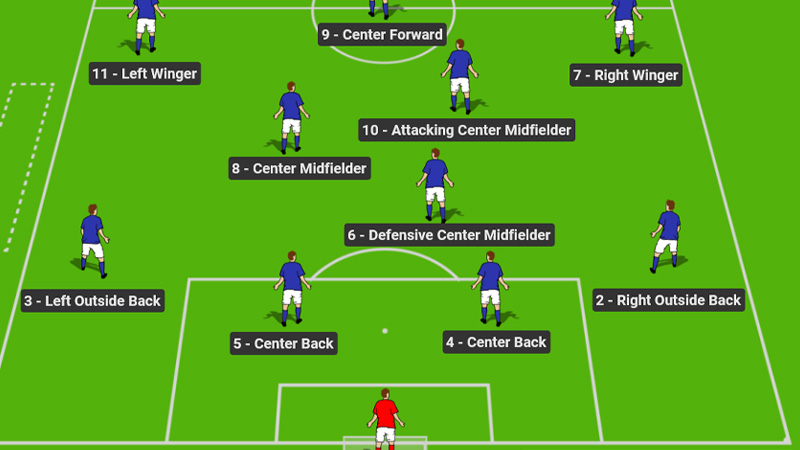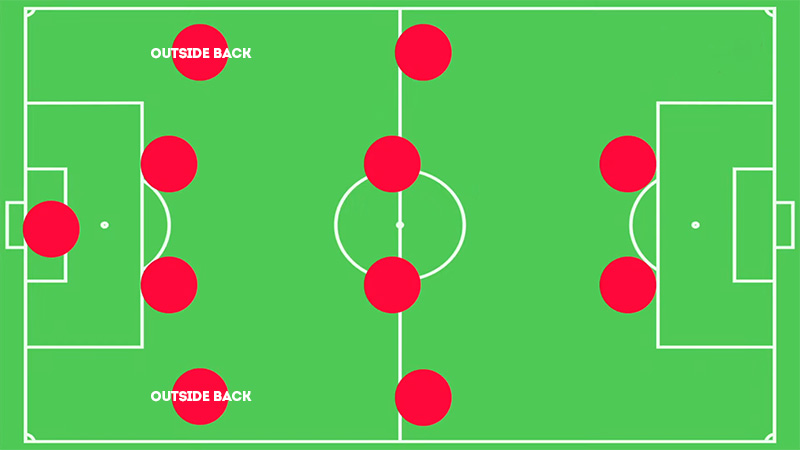The soccer outside back position is a pivotal role that demands a perfect blend of defensive solidity and attacking flair.
Positioned on the flanks of the defensive line, outside backs play a crucial role in providing defensive cover, thwarting opposing wingers, and preventing dangerous crosses into the penalty area.
Simultaneously, they contribute to their team’s attacking endeavours by making overlapping runs down the wings, delivering accurate crosses, and supporting the midfield and forwards in the offensive third.
The outside back’s versatility, speed, and tactical awareness make them key players in modern soccer, bridging the gap between defence and attack.
In this exploration, we delve into soccer outside back position, uncovering the skills, techniques, and strategies required to excel in this dynamic position.
What Is Soccer Outside Back Position?
The soccer outside back, also known as the full-back, is a position on the field typically found in a defensive role but with the added responsibility of supporting the team’s attacking play.
Outside backs are positioned on the left and right flanks of the defence, and their main objective is to provide defensive cover and prevent opposing players from making dangerous advances down the wings.
Key Responsibilities of Outside Backs:
Defensive Duties
Outside backs must excel in defensive tasks, including marking and tackling opposing wingers or attackers.
They aim to disrupt the opponent’s attacks and prevent crosses from being delivered into the penalty area.
Overlapping Runs
While their primary role is defensive, outside backs are also expected to make overlapping runs down the wings to support the team’s attacking moves.
By advancing forward, they can stretch the opposition’s defence and create additional width in the attacking third.
Crossing and Assisting
When outside backs reach advanced positions on the flanks, they are expected to deliver accurate crosses into the box, aiming to set up scoring opportunities for their teammates.
Defensive Positioning
Outside backs need to maintain a good defensive position to cover spaces left behind when they venture forward. They must possess the pace and stamina to recover quickly when transitioning from attack to defence.
Playing from the Back
Modern outside backs are also proficient in ball distribution and ball retention. They are often involved in building up play from the back, contributing to the team’s possession-based style of play.
The soccer outside back position requires a combination of defensive skills, attacking prowess, and tactical awareness.
Outside backs are crucial players in modern soccer, providing defensive stability while adding width and dynamism to their team’s attacking play.
Tips And Techniques On The Outside Back Position In Soccer

Source: coachingamericansoccer
Sure, here are some tips and techniques to excel in the outside back position in soccer:
Defensive Positioning and Reading the Game
As an outside back, your defensive positioning is crucial. Maintain a compact shape with the defensive line, and stay goalside of your opponent.
Anticipate the movements of the attacking players, read the game, and be ready to intercept passes or make well-timed tackles. Avoid being caught out of position, as it can leave gaps in the defence.
Overlapping Runs with Timing
Timing your overlapping runs down the wing is a key offensive weapon as an outside back. Choose the right moments to advance forward, considering the team’s possession and attacking phases.
Your runs should stretch the opposition’s defence, creating space for your teammates and providing an extra attacking option.
Crossing and Passing Accuracy
Work on your crossing and passing accuracy to become a threat in the attacking third. Practice delivering both low-driven crosses and lofted balls into the box to find your teammates in scoring positions.
Additionally, improve your short passing skills to build up play from the back and maintain possession during transitions.
1v1 Defending
Outside backs often find themselves in one-on-one defensive situations against speedy wingers or skilful attackers. Focus on your 1v1 defending, stay on your feet, and avoid diving into tackles too early.
Use your body to guide the opponent away from dangerous areas and force them onto their weaker foot.
Communication and Coordination
Communication with your teammates is vital in all areas of the pitch, but especially so for outside backs.
Constantly communicate with your centre-backs, midfielders, and wingers to maintain defensive organization and execute coordinated attacking movements.
Speed and Endurance
Develop your speed and endurance to cover the flanks effectively. As an outside back, you’ll need to support the attack and quickly recover to defend. Regularly work on your fitness to ensure you can maintain a high level of performance throughout the match.
Decision Making
Improve your decision-making abilities both on and off the ball. Know when to pass, when to dribble, when to stay back, and when to make overlapping runs.
Smart decision-making will allow you to contribute effectively in both the defensive and offensive phases of the game.
Mental Toughness
Lastly, as an outside back, you may face challenging situations, such as tracking back against a counter-attack or being isolated against a skilful winger.
Develop mental toughness to stay focused, remain composed, and overcome these challenges with confidence.
By honing these tips and techniques, you can become a dynamic and influential outside back, making a significant impact on your team’s performance both defensively and offensively.
FAQ
What is the soccer outside back position?
The soccer outside back position, also known as the full-back, refers to players stationed on the left and right flanks of the defensive line. They play a crucial role in both the defensive and attacking phases of the game, providing defensive cover while supporting the team’s offensive moves down the wings.
What are the primary responsibilities of an outside back?
Outside backs have dual responsibilities. Defensively, they must mark and tackle opposing wingers or attackers, preventing them from making dangerous advances down the flanks.
How can an outside back improve their defensive skills?
To enhance defensive skills, outside backs should focus on maintaining a good defensive shape, reading the game, and anticipating the opponent’s movements. Practice 1v1 defending to improve tackling and marking abilities.
What techniques can outside backs use to contribute to the team’s attack?
Outside backs can contribute to the attack by making well-timed overlapping runs down the wing. Develop accurate crossing and passing abilities to deliver balls into dangerous areas and create scoring opportunities for teammates.
How important is physical fitness for outside backs?
Physical fitness is crucial for outside backs, as they need to cover extensive ground during a match. Improving speed, agility, and endurance will enable them to support the attack and quickly recover to defend.
Conclusion
The soccer outside back position is a critical component of a well-balanced team, and its importance continues to grow in modern soccer. These versatile players act as defensive stalwarts while also contributing significantly to the team’s attacking play.
Their ability to read the game, make overlapping runs, and deliver precise crosses adds a new dimension to their team’s offensive arsenal.
As the game evolves, outside backs have become essential players, often seen as the engine that drives the team forward and maintains defensive stability.
By mastering defensive positioning, improving crossing and passing accuracy, developing 1v1 defending skills, and maintaining peak physical fitness, outside backs can excel in this demanding position and leave a lasting impact on the game.







